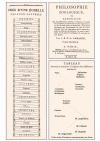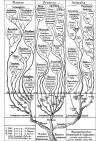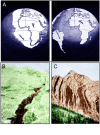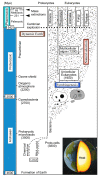From the scala naturae to the symbiogenetic and dynamic tree of life
- PMID: 21714937
- PMCID: PMC3154191
- DOI: 10.1186/1745-6150-6-33
From the scala naturae to the symbiogenetic and dynamic tree of life
Abstract
All living beings on Earth, from bacteria to humans, are connected through descent from common ancestors and represent the summation of their corresponding, ca. 3500 million year long evolutionary history. However, the evolution of phenotypic features is not predictable, and biologists no longer use terms such as "primitive" or "perfect organisms". Despite these insights, the Bible-based concept of the so-called "ladder of life" or Scala Naturae, i.e., the idea that all living beings can be viewed as representing various degrees of "perfection", with humans at the very top of this biological hierarchy, was popular among naturalists until ca. 1850 (Charles Bonnet, Jean Lamarck and others). Charles Darwin is usually credited with the establishment of a branched evolutionary "Tree of Life". This insight of 1859 was based on his now firmly corroborated proposals of common ancestry and natural selection. In this article I argue that Darwin was still influenced by "ladder thinking", a theological view that prevailed throughout the 19th century and is also part of Ernst Haeckel's famous Oak tree (of Life) of 1866, which is, like Darwin's scheme, static. In 1910, Constantin Mereschkowsky proposed an alternative, "anti-selectionist" concept of biological evolution, which became known as the symbiogenesis-theory. According to the symbiogenesis-scenario, eukaryotic cells evolved on a static Earth from archaic prokaryotes via the fusion and subsequent cooperation of certain microbes. In 1929, Alfred Wegener published his theory of continental drift, which was later corroborated, modified and extended. The resulting theory of plate tectonics is now the principal organizing concept of geology. Over millions of years, plate tectonics and hence the "dynamic Earth" has caused destructive volcanic eruptions and earthquakes. At the same time, it created mountain ranges, deep oceans, novel freshwater habitats, and deserts. As a result, these geologic processes destroyed numerous populations of organisms, and produced the environmental conditions for new species of animals, plants and microbes to adapt and evolve. In this article I propose a tree-like "symbiogenesis, natural selection, and dynamic Earth (synade)-model" of macroevolution that is based on these novel facts and data.
Figures












References
-
- Barlow N, (ed.) The Autobiography of Charles Darwin. London: Collins; 1958.
-
- Kutschera U, Niklas KJ. Evolutionary plant physiology: Charles Darwin's forgotten synthesis. Naturwissenschaften. 2009;96:1339-1354. - PubMed
-
- Kutschera U, Elliott JM. Charles Darwin's observations on the behaviour of earthworms and the evolutionary history of a giant endemic species from Germany, Lubricus badensis (Oligochaeta: Lumbricidae) Appl Environm Soil Sci. 2010;2:1-11.
Publication types
MeSH terms
LinkOut - more resources
Full Text Sources
Research Materials

